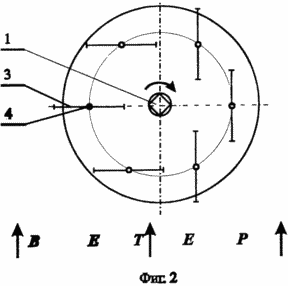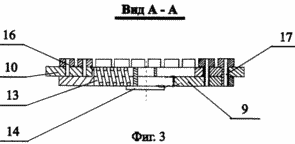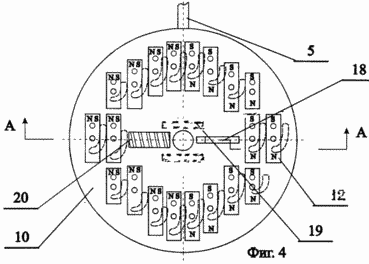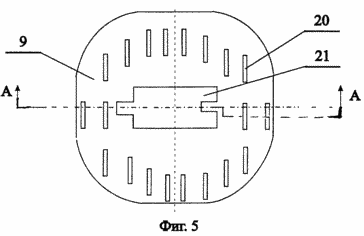| Start of section
Production, amateur Radio amateurs Aircraft model, rocket-model Useful, entertaining |
Stealth Master
Electronics Physics Technologies Inventions |
Secrets of the cosmos
Secrets of the Earth Secrets of the Ocean Tricks Map of section |
|
| Use of the site materials is allowed subject to the link (for websites - hyperlinks) | |||
Navigation: => |
Home / Patent catalog / Catalog section / Back / |
|
INVENTION
Patent of the Russian Federation RU2153599
![]()
Wind turbine for wind turbine
The name of the inventor: Aliev A.S.
The name of the patent holder: Dagestan State University
Address for correspondence: 367025, Republic of Dagestan, Makhachkala, ul. M. Hajiyeva 43 "A", DSU, Department of Intellectual Property
Date of commencement of the patent: 1999.01.18
The invention relates to devices for energy conversion of a fluid and can be used in wind generators. The technical result of synchronizing the speed of rotation of the windmill is achieved due to the fact that in a windmill containing a vertical shaft, vertical blades, a weather vane and a control mechanism, according to the invention, a disk is fixed on the shaft, the blades are flat and mounted on the disc with a possibility of rotation relative to their Vertical axes on the root parts of which are fixed the upper magnets interacting with the lower magnets placed on the turntable associated with the weather vane, and the control mechanism is equipped with a centrifugal speed regulator with a slider, wedge and plate interacting with each other, the plate being mounted on Platform with the ability to linearly move in a direction perpendicular to the plane of the weather vane, the slider of the centrifugal regulator is connected through a wedge with a plate interacting with lower magnets that are pivotally mounted relative to their vertical axes.
DESCRIPTION OF THE INVENTION
The invention relates to devices for energy conversion of a fluid and can be used in wind generators.
The wind engine is one of the most common in the world, since the end of the XV century. The man learned to use the cheap natural wind force, invented a windmill-engine, a power plant that converted the strength of the horizontal component of wind speed into the rotational motion of the engine shaft. However, due to the low efficiency and the invention of other more advanced energy-efficient power converters, wind turbines have not been widely used even in regions where the total duration of the wind season in a year is at least 60%.
A wind turbine is known, which can be indicated as a prototype, comprising a vertical shaft and associated blades made in the form of thin-walled panels with internal blades; cross-sections are made in one of the panel walls. In addition, the windmill is equipped with fixed on the vertical shaft shaped bender curvature limiters with a shape equivalent to the curvature of the blade / 1 /.
The disadvantage of the prototype is a relatively low efficiency, due to the fact that the useful area of the blade depends on the angle of its inclination relative to the direction of the wind and proportionally to cos ![]() , Where
, Where ![]() Varies from 0 to 180 o degrees.
Varies from 0 to 180 o degrees.
Known windmill / 2 /, containing a vertical shaft, vertical blades, a weather vane and a control mechanism.
This wind turbine can be specified as a prototype.
The disadvantage of this wind turbine is that the speed of rotation depends on the speed of the wind.
The aim of the invention is to synchronize the rotation speed of the windmill. The goal is achieved by the fact that in a windmill containing a vertical shaft, a disk fixed to the shaft, flat vertical blades mounted on the disk with a possibility of rotation relative to their vertical axes, a wind vane, a rotary platform placed coaxially to the shaft, lower and upper magnets interacting with each other , A new regulatory mechanism was introduced.
Unlike the prototype, the control mechanism is equipped with a centrifugal speed regulator with a slider, wedge, plate. The plate is mounted on a platform with the ability to linearly move in a direction perpendicular to the plane of the weather vane.
The slider of the centrifugal regulator is connected to the plate through the wedge. The lower magnets are mounted on the platform perpendicular to the diametral plane coinciding with the plane of the weather vane, with the possibility of rotation relative to its vertical axes. The upper magnets are installed parallel to the side surfaces of the blades.
A comparative analysis of existing designs of wind turbines has shown that the characteristics given in this technical solution were not used in known designs and therefore are significant.
The operating principle of the wind turbine is illustrated in Fig. 15.
 |
 |
 |
 |
 |
In Fig. 1 is a view from the side of the wind turbine in section A: A, where: |
|
In Fig. 2 is a top view of the engine. In Fig. 3 shows the construction of the plate 9 and the rotary platform 10 in a section, |
In Fig. 4 shows the view of the turntable from above with the lower magnets 12 mounted on it: In Fig. 5 shows a view of the plate 9 from above: |
Wind turbine works as follows. Fixed platform 15 is a rack providing the necessary height of the windmill for effective and safe operation. The vertical shaft 1 is hingedly connected to the fixed platform 15. The disk 2 is mounted on the shaft 1 motionless. This can be provided with a key, a pin or spline connection. Thus, the disc 2 and the associated shaft 1 rotate relative to the fixed platform 15.
At the periphery of the disk 2 in a circle, at least three flat blades 3 are installed at an equal distance from each other at a concentric shaft. FIG. 1 wind turbine has six blades installed through 360 o / N = 60 degrees, where N is the number of blades. Each of the blades has a vertical axis of rotation 4, fixed to it motionless and symmetrical to its surface. The axes of the blades 4 are hingedly connected to the disk 2 so that they are parallel to each other and to the shaft 2 of the windmill.
Since the plane of each of the blades with their axes is divided into two symmetrical parts with the same areas, the moments of rotation created by the two halves of the blades relative to their axes are equal. In this case, the blades can be oriented with respect to the wind direction arbitrarily.
For the orientation of the blades in the necessary direction with respect to the direction of the wind, magnets are used.
For this purpose, each blade is provided with an upper magnet 11 fixed to the blade axis at the root portion. In this case, the poles of the SN magnets are oriented along (or perpendicularly) to the planes of the blades 3.
In addition, the device is provided with a turntable 10 fixedly connected to the wind direction indicator 5 (for example, a weather vane). The rotary platform 10 rotates around the shaft 1 relative to the fixed platform 15 when the direction of the wind is changed. On the moving platform 10, from the side of the disk 2, along the circumference along which the axes of the blades 4 rotate, the lower magnets 12 are mounted (see Figures 3, 4). Moreover, the poles of the NS magnets located on the movable platform, on a segment equal to half the circumference, are oriented in the same direction coinciding with the poles of the magnets fixed on the axes of the blades. On the remaining (second) section, the magnets are oriented in a direction perpendicular to the first. The boundary of these sections coincides with the direction indicator of the wind (weathervane) direction (see Figure 4).
In this case, the left section (see Figure 2) corresponds to the active half-cycle of the blade rotation around the shaft 1, when its plane is perpendicular to the direction of the wind flow.
At the interface between the active and passive sections, the torque generated by the blade due to the small arm is zero.
In the interaction of the upper magnets rigidly fixed on the axes of the blades, with the lower magnets fixed on the moving platform, the orientation of the blades with respect to the direction of the wind changes. In this case, with a weak wind in the active area (in Figures 1 and 3 - the left half), the blades are installed perpendicular to the direction of the wind. In the entire active area, when the blade rotates together with the body and the shaft, the position of the blade relative to the body is constantly corrected by magnets and adheres perpendicular to the direction of the wind.
As soon as the axis of the blade 4 and the upper magnet 11 secured to it reach the passive section (in Figures 1 and 3 - the right half), due to interaction with the lower magnets, the blade changes its orientation by 90 ° and becomes along the direction of the wind.
When the blade rotates together with the disk 2 within the passive section, the orientation of the blade adheres to a constant - perpendicular to the direction of the wind blade.
Thus, with a weak wind, each of the blades relative to the direction of the wind assumes a position perpendicular - in the active section; Along - on the passive site.
At each moment of time of the six blades three blades (in Figure 1 - left) are in the working position, and the remaining three - in the idle (right).
Since the blades in the working position permanently retain the orientation perpendicular to the direction of the wind, the force created by the wind pressure on the blade surface does not change when the windmill body rotates. This provides an increase in engine efficiency at low wind speeds.
To stabilize the rotation speed of the motor shaft 1, a centrifugal speed control 6 is used. When the shaft speed is increased above the nominal speed, the slide 7 is lowered downward. The speed at which the goods of the centrifugal regulator diverge is determined by their mass and the dimensions of the arms of the regulator. The slider pulls down the wedge 8. The wedge, in turn, displaces the plate 9 in a horizontal position with respect to the rotary platform 10. FIG. 3 is a sectional view AA of the rotatable platform 10 and the plate 9, a plan view, on which are respectively shown in FIG. 4 and 5. For the linear displacement of the plate, guide plates 19 are used, fixed immovably on the turntable from below.
These guides 19 run along the groove 21 of the plate 9. The groove 18 serves to install the wedge 8. The spring 20 returns the plate 9 to the extreme left position and constantly presses the plate against the wedge. Thus, moving the wedge up and down converts to a proportional movement of the plate left-right. The thrust washer 14 locks the horizontal position of the plate 9 and the turntable 10. On the turntable, along the circumference along which the root parts of the blades rotate, the lower magnets 12 are rotatably mounted.
Each of these magnets has its pivot axis 16 and an opening in which pins 17 are fixedly mounted. The free ends of the pins enter the poses 20 of the plate 9. When the plate is moved to the right, the pins 17 rotate each of the lower magnets around the axes 16 counterclockwise (see Fig. . 4).
On the left half of the turntable relative to the diametral plane coinciding with the plane of the weather vane, the direction NS of the lower magnets 16 is perpendicular, and on the right half - coincides with the plane of the weather vane.
As the speed of rotation of the shaft increases, the plate 9 interacts through the slots 20 with the pins 17, turns the lower magnets 12 around its axes 16. The orientation of the NS direction of the upper magnets 11 coincides with the plane of the blades 3.
The interaction of the lower and upper magnets with their relative motion leads to a change in the orientation of the blades.
If, in a weak wind, the orientation of the plane of the blades on the left half of the turntable is perpendicular, on the right half they coincide with the plane of the weathervane, i.e. Direction of the wind.
When the wind speed is increased, the rotation speed of the shaft 1 is increased. The centrifugal speed control 6 through the wedge 8 and the plate 9 changes the position of the lower magnets by an angle of less than 45 ° . This, in turn, changes the position of the blades relative to the direction of the wind. The effective area of the blades on the left half of the turntable, which creates the moment of rotation of the shaft, decreases. On the left half, the area of the blade, which creates a negative moment, increases. This will reduce the speed of rotation of the shaft.
Thus, a dynamic equilibrium is established and the shaft rotation speed is stabilized.
If you rotate the lower magnets by 45 ° relative to the direction of the wind, then the effective area of the blades on the left and right halves of the platform will be the same, the positive and negative moments of rotation will be equal to each other and the engine will not rotate at all. Such a case can not be, ie, at a low speed of rotation of the shaft, the centrifugal rotary regulator puts the wedge in an extremely upper position and the lower magnets of the right and left halves of the platform are oriented mutually perpendicular (see Figure 4). This ensures the maximum torque generated by wind pressure on the plane of the blades of the left half.
Synchronicity of rotation of the output shaft of the wind turbine will make it possible to create on its basis a wind energy system with constant voltage and frequency.
INFORMATION SOURCES
1. Vavilov VD, Vavilov AD, Vavilov IV Wind turbine. AS of the USSR N 1962518, cl. F 03 D 3/00.
2. US 4,052,134, cl. F 03 D 7/06, 04.10.77 Wind engine (prototype).
CLAIM
A windmill comprising a vertical shaft, vertical blades, a weather vane and a control mechanism, characterized in that a disk is fixed on the shaft, the blades are flat and mounted on the disk with a possibility of rotation relative to their vertical axes, on the root parts of which are fixed the upper magnets interacting with the lower magnets Placed on a turntable connected to a weather vane, and the control mechanism is provided with a centrifugal speed controller with a slider, a wedge and a plate cooperating with each other, the plate being mounted on the platform with a linear movement in a direction perpendicular to the plane of the weather vane, the slider of the centrifugal regulator Is connected through a wedge with a plate interacting with lower magnets, which are pivotally mounted relative to their vertical axes.
print version
Publication date 31.01.2007gg




Comments
Commenting on, remember that the content and tone of your message can hurt the feelings of real people, show respect and tolerance to your interlocutors even if you do not share their opinion, your behavior in the conditions of freedom of expression and anonymity provided by the Internet, changes Not only virtual, but also the real world. All comments are hidden from the index, spam is controlled.